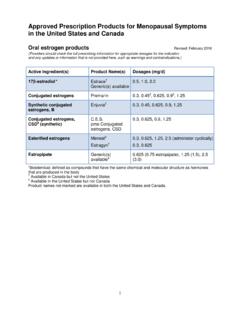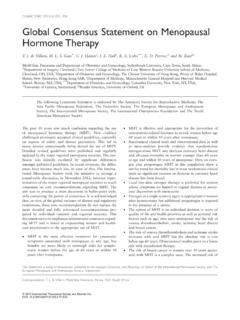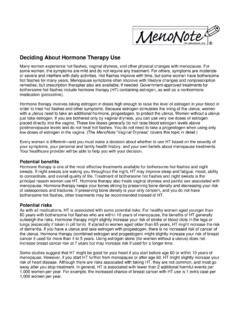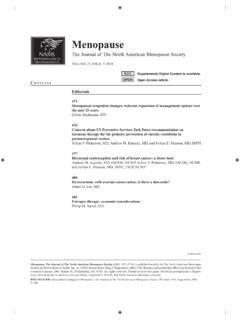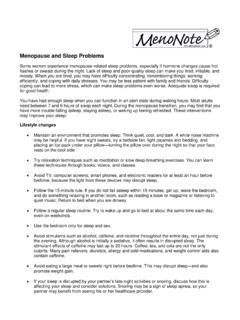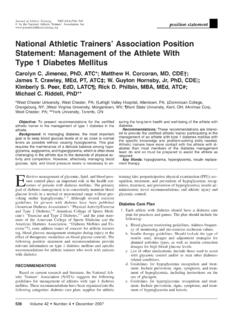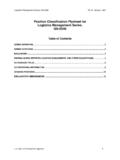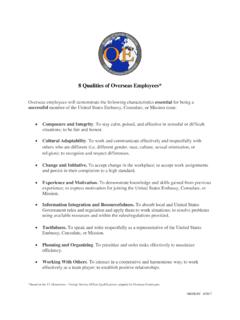Transcription of Management of osteoporosis in postmenopausal women: the ...
1 NAMS POSITIONSTATEMENTM anagement of osteoporosis in postmenopausal women: the 2021position statement of The North American Menopause SocietyAbstractObjective:To review evidence regarding osteoporosis screening, prevention, diagnosis, and Management in thepast decade and update the position statement published by The North American Menopause Society (NAMS) in2010 regarding the Management of osteoporosis in postmenopausal women as new therapies and paradigms havebecome :NAMS enlisted a panel of clinician experts in the field of metabolic bone diseases and/or women s healthto review and update the 2010 NAMS position statement and recommendations on the basis of new evidence andclinical judgement. The panel s recommendations were reviewed and approved by the NAMS Board of : osteoporosis , especially prevalent in older postmenopausal women, increases the risk of fractures thatcan be associated with significant morbidity and mortality.
2 postmenopausal bone loss, related to estrogendeficiency, is the primary contributor to osteoporosis . Other important risk factors for postmenopausal osteoporosisinclude advanced age, genetics, smoking, thinness, and many diseases and drugs that impair bone health. Anevaluation of these risk factors to identify candidates for osteoporosis screening and recommending nonpharmaco-logic measures such as good nutrition (especially adequate intake of protein, calcium, and vitamin D), regularphysical activity, and avoiding smoking and excessive alcohol consumption are appropriate for all postmenopausalwomen. For women at high risk for osteoporosis , especially perimenopausal women with low bone density and otherrisk factors, estrogen or other therapies are available to prevent bone loss.
3 For women with osteoporosis and/or otherrisk factors for fracture, including advanced age and previous fractures, the primary goal of therapy is to prevent newfractures. This is accomplished by combining nonpharmacologic measures, drugs to increase bone density and toimprove bone strength, and strategies to reduce fall risk. If pharmacologic therapy is indicated, government-approved options include estrogen agonists/antagonists, bisphosphonates, RANK ligand inhibitors, parathyroidhormone-receptor agonists, and inhibitors of : osteoporosis is a common disorder in postmenopausal women. Management of skeletal health inpostmenopausal women involves assessing risk factors for fracture, reducing modifiable risk factors through dietaryand lifestyle changes, and the use of pharmacologic therapy for patients at significant risk of osteoporosis or women with osteoporosis , lifelong Management is necessary.
4 Treatment decisions occur continuously over thelifespan of a postmenopausal woman. Decisions must be individualized and should include the patient in the processof shared Words:Bisphosphonates Bone mineral density Calcium Estrogen agonists/antagonists Falls Fractures osteoporosis Parathyroid hormone-receptor agonists Postmenopause Prevention RANK ligand inhibitors Vitamin can be a serious health threat for post-menopausal women by predisposing them to frac-tures that may be associated with substantialmorbidity and mortality, especially in older women. Clinicalmanagement cannot be defined or confined only by evi-dence. There is no single or optimal Management strategyfor a chronic disorder such as osteoporosis .
5 When evidenceis lacking, clinicians use clinical judgement, consisting ofReceived June 8, 2021; revised and accepted June 8, position statement was developed by The North American Meno-pause Society (NAMS), with representatives of the NAMS Board ofTrustees and other experts in women s health: Jennifer Blake, MD;Felicia A. Cosman, MD; E. Michael Lewiecki, MD, FACP, FACE;Michael R. McClung, MD, FACP, FACE; JoAnn V. Pinkerton, MD,FACOG, NCMP; and Marla Shapiro, MD, CM, CCFP, MHSc, FRCP(C), Board of Trustees conducted independent review and revision andapproved the position statement on June 7, position statement was made possible by donations to the NAMSE ducation & Research was no commercial correspondence to: The North American Menopause Society,30050 Chagrin Blvd, Suite 120W, Pepper Pike, OH 44124.
6 Website: , Vol. 28, No. 9, 2021973 Menopause: The Journal of The North American Menopause SocietyVol. 28, No. 9, pp. 973-997 DOI: 2021 by The North American Menopause Societyindividualized Management decisions for each patient and fordifferent stages in the course of the disease and based on acombination of known evidence, knowledge of the physiol-ogy of the problem being addressed, and their North American Menopause Society (NAMS) createsposition statements on specific disorders to provide reliableand accurate information regarding Management of meno-pause-associated health conditions. Here, NAMS providesguidance on the diagnosis, assessment, prevention, and treat-ment of osteoporosis in postmenopausal women in recommendations herein are based, where possible, onevidence provided by clinical trials and, where evidence doesnot exist, current best clinical practice in the opinions andclinical judgment of an editorial panel consisting of cliniciansand researchers with expertise in metabolic bone diseases orwomen s health.
7 These statements do not represent guidelinesor codified practice standards as defined by regulating bodiesand insurance agencies. Rather, the editorial panel hasattempted to provide sufficient information for clinicians toapproach postmenopausal women with or at risk for osteopo-rosis with a confident understanding of Management recommendations are focused on the perceptions of theneeds of healthcare professionals caring for the skeletal healthof postmenopausal women in the primary care setting. Theguidance provided herein is generally consistent with recom-mendations for the assessment and treatment of postmeno-pausal osteoporosis available from several other NorthAmerican societies and position statement is an update of the 2010 positionstatement, Management of osteoporosis in PostmenopausalWomen.
8 9 Since then, several new medications with sophis-ticated mechanisms of action have received governmentapproval on the basis of randomized, controlled trial (RCT)data. In addition, new knowledge about the pathophysiologyand epidemiology of postmenopausal osteoporosis hasbecome available, as have new perspectives about the roleof hormone therapy (HT) in the Management of skeletalhealth, longer experience with the efficacy and safety of olderosteoporosis drugs, the potential role of drug holidays forbisphosphonates, and new paradigms regarding sequential useof and anabolic and antiremodeling osteoporosis advances have created the need to update the this revision, NAMS enlisted a six-person editorialpanel composed of clinicians and researchers with expertise inmetabolic bone diseases or women s health to review the 2010position statement, identify key studies and evidence pub-lished subsequently, and reach consensus on recommenda-tions.
9 The editorial panel reviewed clinical studies publishedin English related to osteoporosis Management in postmen-opausal women. Priority was given to evidence from RCTsand meta-analyses of such trials, followed by evidence fromsystematic reviews and controlled observational studies,using criteria described standards ofcare and available treatment options differ throughout theworld, the focus is limited to therapies for postmenopausalosteoporosis available in North America. The NAMS Boardof Trustees was responsible for the final review and approvalof this position PATIENTS FOR AND WITHOSTEOPOROSISB ackgroundOsteoporosis the most common bone disorder affectinghumans is a generalized skeletal disorder characterized bycompromised bone strength, predisposing a person to anincreased risk of fracture, most importantly of the spineand and other serious fractures occur mostcommonly in older postmenopausal women and are oftenlife-altering events.
10 However, the bone loss that results inosteoporosis is most marked during the menopause transitionand early menopause. Less serious fractures, such as wristfractures, occur in young postmenopausal women and areimportant warning signs of with osteoporosis and high risk of fracture can bereadily identified. Both general and pharmacologic manage-ment strategies are available to slow or prevent bone loss andto reduce fracture risk. Because osteoporosis is such a com-mon disorder, skeletal health assessment should be a part ofthe routine evaluation of all postmenopausal women, and allprofessionals caring for postmenopausal women should becompetent and confident about undertaking that adults, bone tissue undergoes constant change by aprocess calledbone remodeling.
